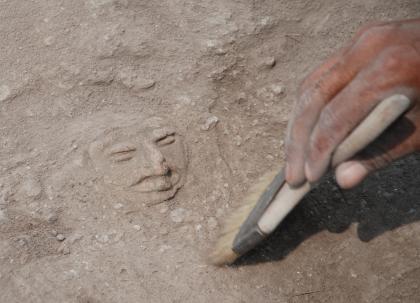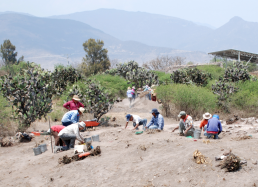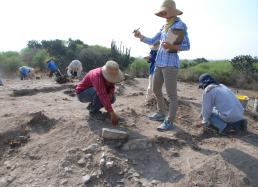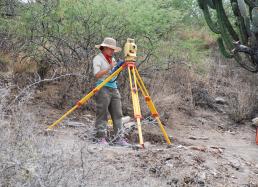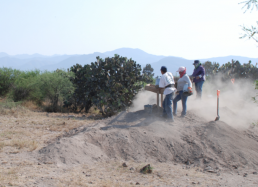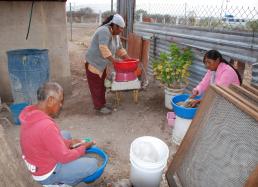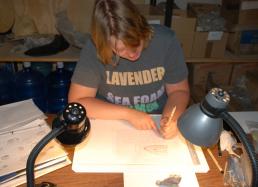4: Patience
In our modern world of 24-hour news cycles, a deluge of instantaneous information at our fingertips, and the ability to contact people anytime and anywhere, patience these days seems to be neither a necessity, nor is it considered a virtue. To be honest, by nature I'm no different than most, as impatient as the next guy. Yet over the decades, if I've acquired any greater tolerance for the long view or the waiting game, I owe that lesson to my time in Oaxaca and my career as an archaeologist.
Having lived and studied for a good chunk of my life in rural Oaxaca, I'd be foolish not to have adapted my perspectives on time and impetuousness to a degree. Life’s pace simply is not the same here as it is in urban contexts, and complete inflexibility to that reality may find a way to work for today or for this field season, but what about the next season, and the ones after that?
It's hard to imagine that just a few decades ago, Linda and I would stop in Laredo (Texas) on our way to fieldwork, where we'd call our parents and let them know that we'd try to write occasionally and call if there were an emergency, but if all went to plan, they just might not hear directly from us for three or four months.
Archaeology dictates many of the same lessons. I vividly remember one of the last days of the 2007 field season, a season during which we'd excavated the ballcourt at El Palmillo and then had started working on the top surface of the adjacent palace. As we excavated down, Linda and I both saw the clues that there likely was a tomb associated with a lower occupation of this complex, but we realized that there was no way we could finish the work that season. So we stopped, covered (backfilled) the site, and began the long wait to the 2008 field season.
Of course, we didn't know beyond a shadow of doubt what was there, but we had a pretty good idea. When we returned in Spring 2008, we didn't jump right into an exploration of the exact spot where we thought we might find a tomb, but rather, we spent six weeks carefully peeling back the building surfaces above and associated with the tomb, so that when we finally started to excavate the suspect area, we could place any discovered feature in broader context.
Fortunately, we were lucky enough to discover an elaborate tomb with ample grave offerings, and you can read about those findings in my first blog from the 2009 season: "Big News and New Beginnings." You can also delve into more stories about the associated palace and nearby ballcourt in my 2008 El Palmillo Archives.
Clearly, degrees of patience, though certainly not resignation, were in order this spring as the social conflicts in Mitla initially impeded our planned research. Naturally when those challenges passed, and we were able to get started at Lambityeco, we were eager to find something interesting and interpretable to make up for lost time. But to a degree, patience was again in order.
First, Mound 165, where we elected to study, was covered with spiny vegetation that needed to be cleared. That effort required several days. Then, once we actually began to excavate (see the series of photos below), the top (and last) prehispanic occupational surfaces of Mound 165 were neither easy to interpret nor particularly photogenic (an aside note: we're presently working on the sixth and perhaps earliest surface of this complex).
Unfortunately, the roots of the aforementioned plants on the flat top of this low mound, early 20th-century farming along the mound’s edges, the previously discussed looting, as well as a relative paucity of construction stone made architectural reconstructions more difficult than we generally found during excavations at El Palmillo.
Stone foundations below adobe walls leave a vital trace for the archaeologist. But when such flat building stones were either removed and recycled, or not used at all (so that adobe walls are situated directly on plaster floors), the archaeological challenge becomes greater.
And yet, even the relative sparsity of building stone used for Mound 165 (compared to El Palmillo and the Mitla Fortress) tells us something. These latter sites were located on rocky hills where construction stone (in the form of outcropping rock and bedrock) was readily available. That's not the case at alluvial Lambityeco, where no ready sources of rock are (or were) close at hand.
But while the architecture of the earliest encountered (top) surfaces were hard to decipher in various ways, we managed painstakingly to figure out the basic occupational surface plans. And while the architecture gave us some fits, almost from the get-go, we began to uncover artifacts that were both exciting and sometimes different from what we encountered at El Palmillo and the Mitla Fortress.
Particularly, we recovered figurine after figurine (see above photo.) In fact, although there is still much to analyze, we presently have more figurines than we recovered in any of the three elaborate residences that we dug at El Palmillo, even though several of the residences were both larger and more elaborate than Lambityeco Mound 165.
How did that figure into the activities of this residence/complex? Prior archaeologists who worked here have long recognized that pottery making and salt production (making brown salt from a saline laguna in the site’s southern sector) were two key economic activities for the populace of Lambityeco. While we agree with this assessment for the site overall, we've found no clear evidence that these two economic pursuits were foci for the inhabitants of Mound 165.
Now, as we've peeled back the layers of this prehispanic complex surface by occupational surface, we're finally finding the kind of architectural preservation that we were hoping for weeks ago. Most of the roots are gone at last, and the twentieth- and twenty-first-century destructive forces (farming and pot hunting) are no longer much of an issue (although the prehispanic inhabitants of the complex did themselves frequently cut pits and holes into prior surfaces).
As we rapidly collect various streams of data, we're hopeful that patience and perseverance will yield key information and new findings. In my next dispatch, I hope to have more on Surface 6 (the seeming foundation of the Mound 165 residential complex) and especially some preliminary speculations concerning the unexpectedly large quantity of figurines we've already found.
More soon,
Gary

